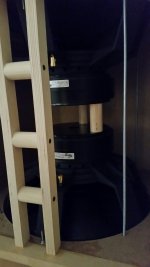Consider two hefty 12" woofers mounted to the sides of the enclosure with their magnets facing each other, properly braced for minimizing vibration.
I am wondering if this arrangement has any detrimental effect on the motors of the drivers, as the magnetic field of each driver is extended in the area occupied by the magnet of the other woofer.
Feeling how strongly each driver "pushes" away from the other, makes me think there is some interaction there.
I am wondering if this arrangement has any detrimental effect on the motors of the drivers, as the magnetic field of each driver is extended in the area occupied by the magnet of the other woofer.
Feeling how strongly each driver "pushes" away from the other, makes me think there is some interaction there.
"Some" would be the operative term, by comparison to the magnetic strength focused in the gap, "some" is not much.Consider two hefty 12" woofers mounted to the sides of the enclosure with their magnets facing each other, properly braced for minimizing vibration.
I am wondering if this arrangement has any detrimental effect on the motors of the drivers, as the magnetic field of each driver is extended in the area occupied by the magnet of the other woofer.
Feeling how strongly each driver "pushes" away from the other, makes me think there is some interaction there.
If you are concerned about it, you could turn one speaker around and reverse the polarity, and do a comparison test. The "push pull" arrangement will increase the cabinet volume slightly (you could put bricks or filled bottles of the volume equivalent to the speaker inside to keep the volume the same), and reduce even order harmonic distortion, but other than that, I doubt you will find any difference in response related to a change in the magnetic field.
I wouldn't suggest it. Apart from the changed magnetic fields and slight loss in the magnetic field (only a few %) you get another major disadvantage. The pole bore (not sure if it's called that, not a native language speaker, sry) can't 'breathe' free. That means, you get higher air compression behind the dustcap, which results in a lot higher mechanical losses (-> Rms). For high power applications it's even worse because the cooling of the voicecoil drops dramatically, that means the rated power drops a lot and the power compression starts at a much lower rating.
Or short: Give them at least 7-10cm distance to each other.
Or short: Give them at least 7-10cm distance to each other.
There's a DIY festival / party speaker called the 'boominator' which has much discussion devoted to it; you could mine those threads for info.
There are many versions, but the main / best version uses back-to-back neodymium magnet PA woofers. Much of the rigidity comes from the coupled driver frames, and I imagine that the force cancellation is a particularly important bonus in light, portable boxes.
There are many versions, but the main / best version uses back-to-back neodymium magnet PA woofers. Much of the rigidity comes from the coupled driver frames, and I imagine that the force cancellation is a particularly important bonus in light, portable boxes.
YOU MEAN LIKE THIS ?
I do apologize for the poor picture quality. This is a push-push, reaction-forced cancelling sub-woofer system using 2 Dayton 460Ho drivers.
It's not clearly visible, but 4 out of the 8 mounting holes have threaded rods in order to compress the 3 dowels that separate the magnet structures.
The "T" bridge in front serves to further add rigidity to the exit slot.
I do apologize for the poor picture quality. This is a push-push, reaction-forced cancelling sub-woofer system using 2 Dayton 460Ho drivers.
It's not clearly visible, but 4 out of the 8 mounting holes have threaded rods in order to compress the 3 dowels that separate the magnet structures.
The "T" bridge in front serves to further add rigidity to the exit slot.
Attachments
No need to apologize, the picture is clearly visible and you've solved the most important problems quite well like the distance between the drivers (looks okay from the picture), the driver spacers/connections and the baffle connection rods. I'd prefer wood for the baffle connection because of the much lower resonance but I think your solution works fine as well.I do apologize for the poor picture quality. This is a push-push, reaction-forced cancelling sub-woofer system using 2 Dayton 460Ho drivers.
Every structual improvement is preferable, so thumbs up for that too. 🙂The "T" bridge in front serves to further add rigidity to the exit slot.
- Status
- Not open for further replies.
